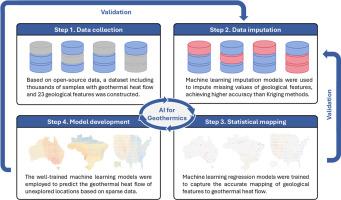利用机器学习的稀疏地质数据预测可持续能源应用中的地热热流
IF 9.6
Q1 COMPUTER SCIENCE, ARTIFICIAL INTELLIGENCE
引用次数: 0
摘要
地热热流(GHF)是地热储层评价的重要指标。为了规避传统GHF测量技术的高成本,利用机器学习模型来预测基于Kriging方法输入的地质数据集的GHF越来越受到关注。然而,一些地质特征的空间分布表现出复杂的数据模式和缺失值,证明需要一种更准确和有效的替代传统的克里格方法。在这项研究中,我们提出了一种新的基于机器学习的框架,用于基于稀疏地质数据预测GHF。具体来说,使用机器学习模型(这里是MissForest)来估算地质数据的缺失值。MissForest模型通过利用地质参数(如上地壳厚度、莫霍深度和岩石类型)之间的空间相关性,比传统的Kriging方法(R2 = 0.84)具有更高的输入精度(R2 = 0.90,缺失率为20%)。基于输入的数据集,训练机器学习回归模型来捕获地质特征到GHF的映射。该模型预测各区域GHF的误差较低,仅为10.18%,优于以往的研究结果。此外,基于机器学习的框架成功地预测了全球GHF,为全球地热资源的分布模式及其开发潜力提供了新的思路。本文章由计算机程序翻译,如有差异,请以英文原文为准。

Prediction of geothermal heat flow for sustainable energy applications with sparse geological data using machine learning
Geothermal heat flow (GHF) is a crucial metric in the assessment of geothermal reservoirs. To circumvent the high cost of conventional GHF measurement techniques, there is a growing interest in leveraging machine learning models to predict GHF based on geological datasets imputed by the Kriging method. However, the spatial distribution of some geological features exhibits complex data patterns and missing values, justifying the need for a more accurate and efficient alternative to the conventional Kriging method. In this study, we present a novel machine learning-based framework for predicting GHF based on sparse geological data. Specifically, a machine learning model (here MissForest) is employed to impute the missing values of geological data. The MissForest model, by leveraging spatial correlations among geological parameters (e.g., upper crust thickness, Moho depth, and rock type), achieves superior imputation accuracy (R2 = 0.90 at 20% missing rate) over the conventional Kriging method (R2 = 0.84). Based on the imputed datasets, machine learning regression models are trained to capture the mapping of geological features to GHF. Our best model achieves a low error of 10.18 % for predicting GHF across various regions, surpassing the previous studies. Furthermore, the machine learning-based framework successfully predicts the GHF globally, shedding new light on the distribution patterns of geothermal resources and their exploitation potential worldwide.
求助全文
通过发布文献求助,成功后即可免费获取论文全文。
去求助
来源期刊

Energy and AI
Engineering-Engineering (miscellaneous)
CiteScore
16.50
自引率
0.00%
发文量
64
审稿时长
56 days
 求助内容:
求助内容: 应助结果提醒方式:
应助结果提醒方式:


